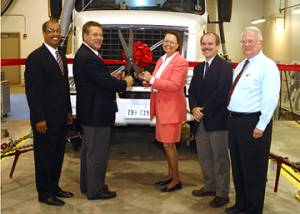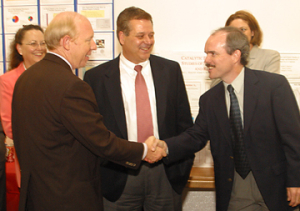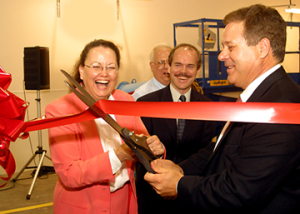The Unveiled Facility Develops and Tests Technologies to Reduce Diesel Engine Emissions
A program to clean up diesel emissions in Houston is ready to shift into high gear as the University of Houston and the City of Houston join forces to clean up our air.
UH’s Diesel Vehicle Research and Testing Facility, initiated in advance of the Bush administration’s Clean Air Nonroad Diesel Rule signed by the EPA in May, was unveiled to the public during a ribbon-cutting ceremony with Houston Mayor Bill White June 28.
In an effort to improve the region’s air quality, the City of Houston is providing $3.8 million to the University of Houston to test new technologies that will help reduce emissions from the city’s diesel fleet of 2,800 vehicles. The focus of the five-year project, headed by UH’s Department of Chemical Engineering, is to conduct diesel testing and data analysis, emission research and technology development. Cash and in-kind contributions from the university bring the total project cost to nearly $5 million.
“Technologies emerging and being researched at our facility are beginning to offer promising possibilities for reducing the polluting emissions found in diesel engine exhaust,” said Michael Harold, professor and chair of UH’s Department of Chemical Engineering and the principal investigator on the air quality project. “Our task is to systematically evaluate the effectiveness of these technologies, especially in reducing nitrogen oxides and particulates. The project is part of a larger UH Cullen College of Engineering effort to develop cleaner engine technology.”
Nitrogen oxides (NOx) are precursor chemicals that react in the atmosphere to form ozone, a key component of smog. Common sources of NOx include cars, trucks, marine vessels, power generation and industrial processes. When the EPA announced in April its determination of the air quality in communities across the nation, the Houston-Galveston nonattainment area did not meet the stricter national standard for ozone.
Scientists are expecting measures such as the new EPA rule and the new UH facility to have as big a health benefit as removing lead in gasoline and installing catalytic converters on cars. The UH facility includes what is essentially a treadmill for heavy-duty trucks and a state-of-the-art emission analysis system that will put diesel-powered vehicles through a series of tests under simulated driving conditions.
“With the notable shortage of facilities to test diesel emission control technologies for their effectiveness, UH fills a need in Southeast Texas,” Harold said. “By analyzing data taken before and after the vehicles are modified, we can evaluate how effective the new devices are in reducing emissions, thereby helping the city make informed decisions about how to invest taxpayer dollars in technologies to reduce emissions in its fleet.”
UH’s chemical engineering department is particularly well suited to take on this project, as chemical engineers played a key role in the development of the automobile catalytic converter during the 1970s. Several of UH’s chemical engineering faculty are experts in this area, and students also are participating in the research associated with the project.



